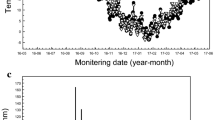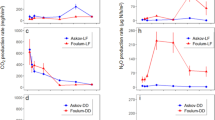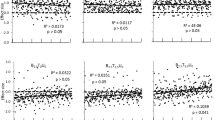Abstract
Nitrous oxide (N2O) emissions and denitrification losses from an irrigated sandy loam soil amended with composted municipal solid waste (MSW), sheep manure (SM), surface applied pig slurry (SPS), incorporated pig slurry (IPS) or urea (U) were studied under Mediterranean conditions. We quantified emissions, in both the presence and absence of maize and N2O production, via denitrification and nitrification pathways using varying concentrations of acetylene. Discounting the N2O lost in the Control, the percentages of N2O lost in relation to the total N applied were greater for urea (1.80%) than for MSW (0.50%), SM (0.46%), SPS (1.02%) or IPS (1.27%). In general, plots treated with organic fertilisers emitted higher amounts of N2O when under maize than bare soil plots. On the other hand, greater denitrification losses were also recorded for plots in the absence of plants (between 9.7 and 29.3 kg N2O-N ha−1) than for areas with plants (between 7.1 and 24.1 kg N2O-N ha−1). The proportion of N2O produced via denitrification was greater from fertiliser treatments than for the controls and also greater without plants (between 66 and 91 % of the N2O emitted) than with plants (between 48 and 81%).





Similar content being viewed by others
References
Azam F, Haide K, Malik A (1985) Transformation of 14C labelled plant components in soil in relation to immobilization-remineralization of 15N fertiliser. Plant Soil 86:15–25
Bouwman AF (1990) Exchange of green house gases between terrestrial ecosystem and the atmosphere. In: Bowman AF (ed) Soils and the Greenhouse Effect, Wiley, Chichester pp 61–127
Bolton H, Smith JL, Wildung RE (1990) Nitrogen mineralization potential of shrub-steppe soils with different disturbance histories. Soil Sci Soc Am J 54:887–891
Cannavo P, Richaume A, Lafolie F (2003) Fate of nitrogen and carbon in the vadose zone: in situ and laboratory measurements of seasonal variations in aerobic respiratory and denitrifying activities. Soil Biol Biochem 36:463–478
Chadwick DR, Pain BF, Brookman SKE (2000) Nitrous oxide and methane emissions following application of animal manures to grassland. J Environ Qual 29:277–287
Dendooven L, Bonhomme E, Merckx K, Vlassak K (1998) Injection of pig slurry and its effects on dynamics of nitrogen and carbon in a loamy soil under laboratory conditions. Biol Fertil Soils 27:5–8
Díez JA, Caballero R, Román R, Tarquis A, Cartagena MC, Vallejo A (2000) Integrated fertiliser and irrigation management to reduce nitrate leaching in Central Spain. J Environ Qual 48:49–56
Firestone MK, Davidson EA (1989) Microbiological basis of NO and N2O production and consumption in soil. In: Andreae MO, Schimel DS (eds) Exchange of Trace Gases Between Terrestrial Ecosystems and the Atmosphere, Wiley, London, pp 7–21
Huang Y, Zou J, Zheng X, Wang Y, Xu X (2004) Nitrous oxide emissions as influenced by amendment of plant residues with different C:N ratios. Soil Biol Biochem 36:973–981
Liang BC, Gregorich EG, Schnitzer M, Voroney RP (1996) Carbon mineralization in soils of different textures as affected by water-soluble organic carbon extracted from composted dairy manure. Biol Fertil Soils 21:10–16
Linn DM, Doran JW (1982) Effect of water-filled pore space on carbon dioxide and nitrous oxide production in tilled and non tilled soils. Soil Sci Soc Am J 48:1267–1272
McKenney DJ, Shuttleworth KF, Vriesacker JR, Findlay WI (1982) Production and loss of nitric oxide from denitrification in anaerobic Brookston Clay. Appl Environ Microb 43:543–541
Müller C, Sherlock RR, Williams PH (1998) Field method to determine N2O emission from nitrification and denitrification. Biol Fertil Soils 28:51–55
Mulvaney RL, Khan SA, Mulvaney CS (1997) Nitrogen fertilisers promote denitrification. Biol Fertil Soils 24:211–220
Nielsen TH, Nielsen LP, Revsbach NP (1996) Nitrification and coupled nitrification-denitrification associated with a soil-manure interface. Soil Sci Soc Am J 60:1829–1840
Paul JW, Beauchamp EG (1993) Nitrogen availability for corn in soils amended with urea cattle slurry and solid and composted cattle manures. Can J Soil Sci 74:147–155
Rochette P. van Bochove E, Prévost D, Angers DA, Cóte D, Bertrand N (2000) Soil carbon and nitrogen dynamics following application of pig slurry for the 19th consecutive year. II. Nitrous oxide fluxes and mineral nitrogen. Soil Sci Soc Am J 64:1396–1403
Scholefield D, Hawkins JMB, Jackson SM (1997) Use of a flowing atmosphere incubation technique to measure the effects of denitrification controls applied to intact cores of a clay soil. Soil Biol Biochem 29:9–10
Smith KA, McTaggart IP, Tsuruta H (1997) Emissions of N2O and NO associated with nitrogen fertilization in intensive agriculture, and the potential mitigation. Soil Use Mange 13:296–304
Thompson RB, Ryden JC, Lockyer DR (1987) Fate of nitrogen in cattle slurry following surface application or injection to grassland. J Soil Sci 38:689–700
Vallejo A, García-Torres L, Diez JA, Arce A, López-Fernández S (2005) Comparison of N losses (NO −3 , N2O, NO) from surface applied, injected or amended (DCD) pig slurry of an irrigated soil in a Mediterranean climate. Plant Soil 272:313–325
Vallejo A, Skiba U, García-Torres L, Arce A, López-Fernández S, Sánchez-Martín L (2006) Nitrogen oxides emission from soils bearing a potato crop as influenced by fertilization with treated pig slurries and composts. Soil Biol Biochem 38:2782–2793
Wever H, Mussen S, Merckx R (2002) Dynamics of trace gas production following compost and NO −3 amendments to soil at different initial TOC/NO −3 ratios. Soil Biol Biochem 34:1583–1591
Webster EA, Hopkins DW (1996) Contributions from different microbial processes to N2O emission from soil under different moisture regimes. Biol Fertil Soils 22:326–330
Acknowledgements
The authors are grateful to the Spanish Commission of Science and Technology (Project AGL2000 1554−C02) for financing this research. It is also a pleasure to acknowledge Ana Muelas, Demetrio González and Asunción de Diego for their technical assistance. We would like to thank Mark Theobald and Phil Nightingale for his useful comments.
Author information
Authors and Affiliations
Corresponding author
Rights and permissions
About this article
Cite this article
López-Fernández, S., Díez, J.A., Hernáiz, P. et al. Effects of fertiliser type and the presence or absence of plants on nitrous oxide emissions from irrigated soils. Nutr Cycl Agroecosyst 78, 279–289 (2007). https://doi.org/10.1007/s10705-007-9091-9
Received:
Accepted:
Published:
Issue Date:
DOI: https://doi.org/10.1007/s10705-007-9091-9




